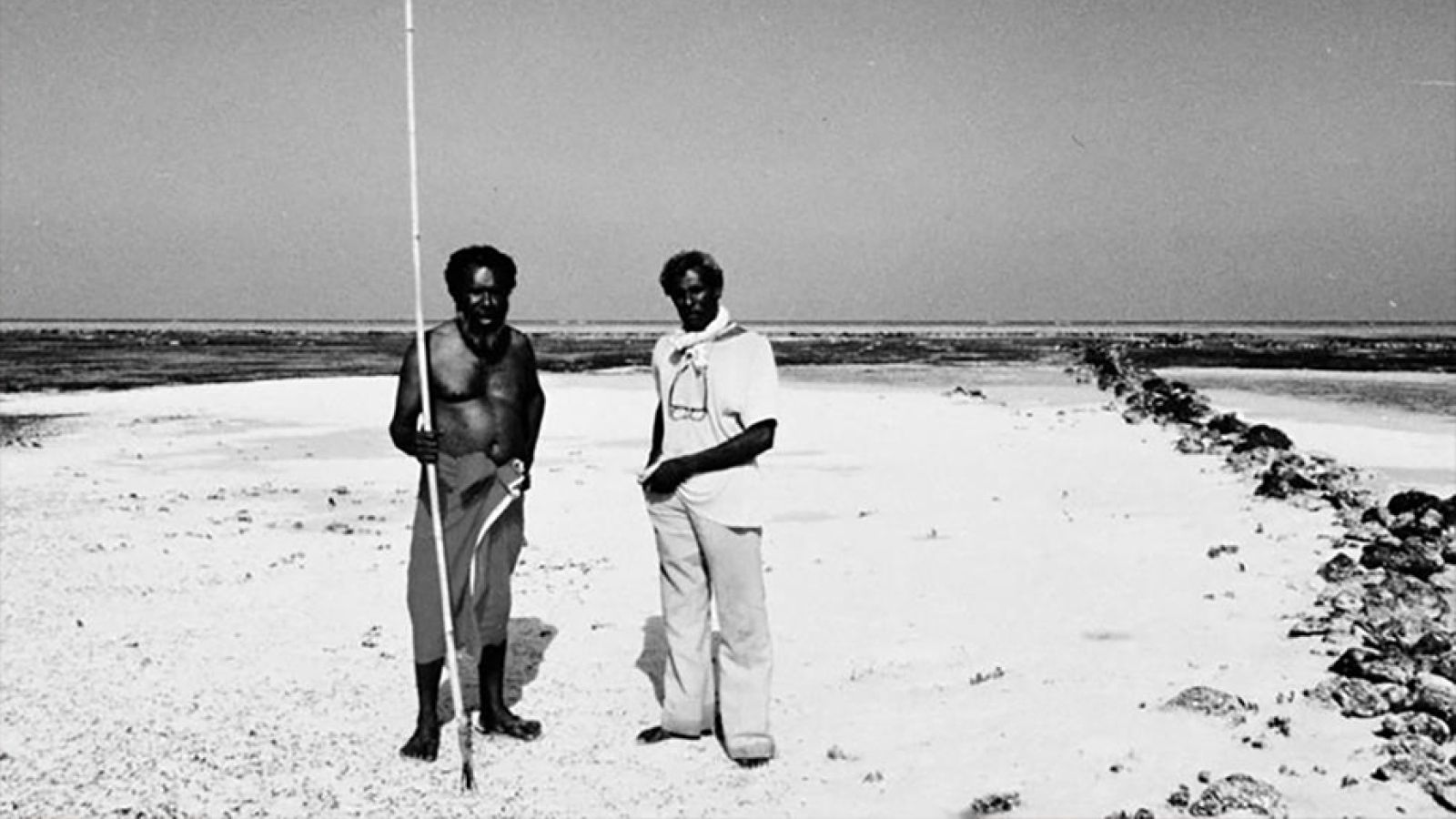1992 - Mabo v. Queensland

Eddie Koiki Mabo (with fishing spear) and Jack Wailu on the Island of Mer in the Torres Strait Islands – 1989 [This image is reproduced with the permission of Trevor Graham Yarra Bank Films Pty Ltd]. Credit: AA: A6180, 9/3/94/23
Written by Henry Reynolds
On 3 June 1992 the High Court of Australia handed down its judgement in the case of Mabo v. Queensland [No.2]. It had been before the courts since May 1982 when five Meriam people from Murray Island (Mer) in the eastern Torres Strait began proceedings to assert their right to their traditional lands. The Queensland government, adopting the traditional legal doctrine of terra nullius that had been at the heart of Australian law since 1788, argued that the land had become the property of the Crown in 1879 when the islands in question had been annexed.
The court made two unexpected decisions. It overthrew terra nullius and found in favour of Eddie Koiki Mabo and the remaining two plaintiffs, David Passi and James Rice. In the imperishable words of Justice Gerard Brennan, the Meriam people were ‘entitled against the whole world to possession, occupation, use and enjoyment’ of their traditional land. If that was not enough, the court decided with a six-to-one majority to apply these same principles to Australia as a whole, and, in the process, to upend legal principles that had endured for 204 years and to retell the history of Australian colonisation.
When the British arrived, they claimed sovereignty over the whole continent in three stages—in 1788 (Sydney), 1824 (Fort Dundas, Melville Island), and 1829 (Swan River, Western Australia)—land over which First Nations peoples exercised rights and managed according to their own laws and customs. The Crown assumed control over the land in a piecemeal manner as settlement spread; however, given Australia’s geography and settlement patterns, there were large areas of the continent, particularly in the north, where traditional land ownership was not usurped. With the passage of the Commonwealth Native Title Act 1993 and the establishment of the National Native Title Tribunal, First Nations communities were enabled to claim native title over their traditional homelands, which they increasingly did.
By 2022 there had been over five hundred successful claims for native title. When added to land reclaimed as a result of the Aboriginal Land Rights (Northern Territory) Act 1976 and South Australian legislation of 1981 and 1984, this meant that Aboriginal and Torres Strait Islander rights and interests in land had been formally recognised across 40 per cent of the Australian land mass. In the Northern Territory and Western Australia, the area in question is much greater, amounting to over 80 per cent in the Kimberley alone.
It has been a transformation of truly global significance.
Sources:
- Australian Institute of Aboriginal and Torres Strait Islander Studies. ‘The Mabo Case.’ Accessed 17 August 2023. https://aiatsis.gov.au/explore/mabo-case
- High Court of Australia. ‘Mabo v Queensland [No 2] [1992] HCA 23.’ Accessed 17 August 2023. https://eresources.hcourt.gov.au/showbyHandle/1/8925
- Museum of Australian Democracy. ‘Documenting Democracy—Mabo v Queensland No. 2 1992 (Cth).’ Accessed 17 August 2023. https://www.foundingdocs.gov.au/item-did-33.html
- National Archives of Australia. ‘Eddie Koiki Mabo and the Mabo Case.’ Accessed 17 August 2023. https://www.naa.gov.au/explore-collection/first-australians/eddie-koiki-mabo-and-mabo-case
- National Museum of Australia. ‘Mabo Decision.’ Accessed 17 August 2023. https://www.nma.gov.au/defining-moments/resources/mabo-decision
- Reconciliation Australia. ‘The Mabo Native Title Decision.’ Accessed 17 August 2023. https://nrw.reconciliation.org.au/wp-content/uploads/2023/05/Mabo-Day-Factsheet-.pdf
This article is republished from the Australian Dictionary of Biography website here.